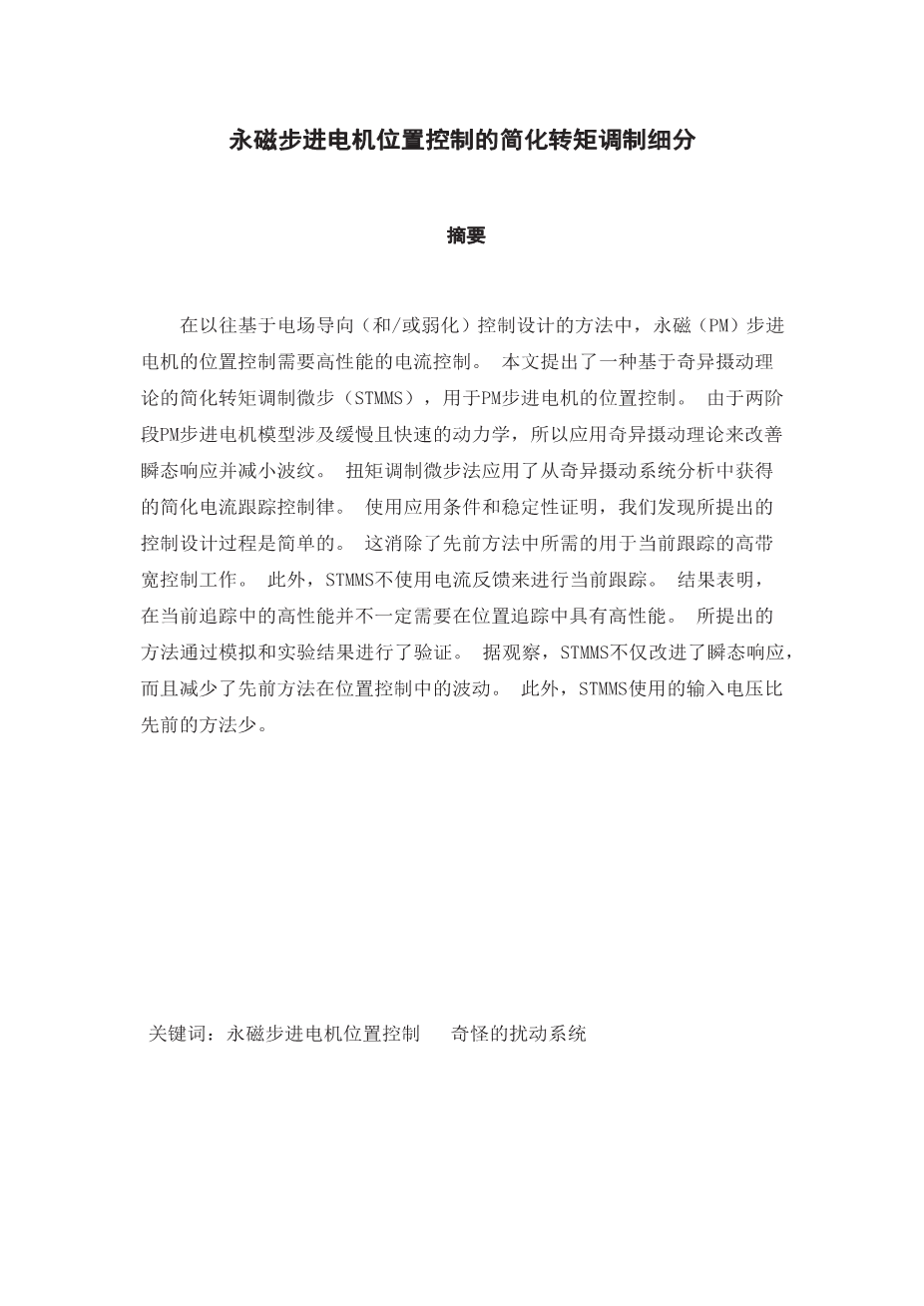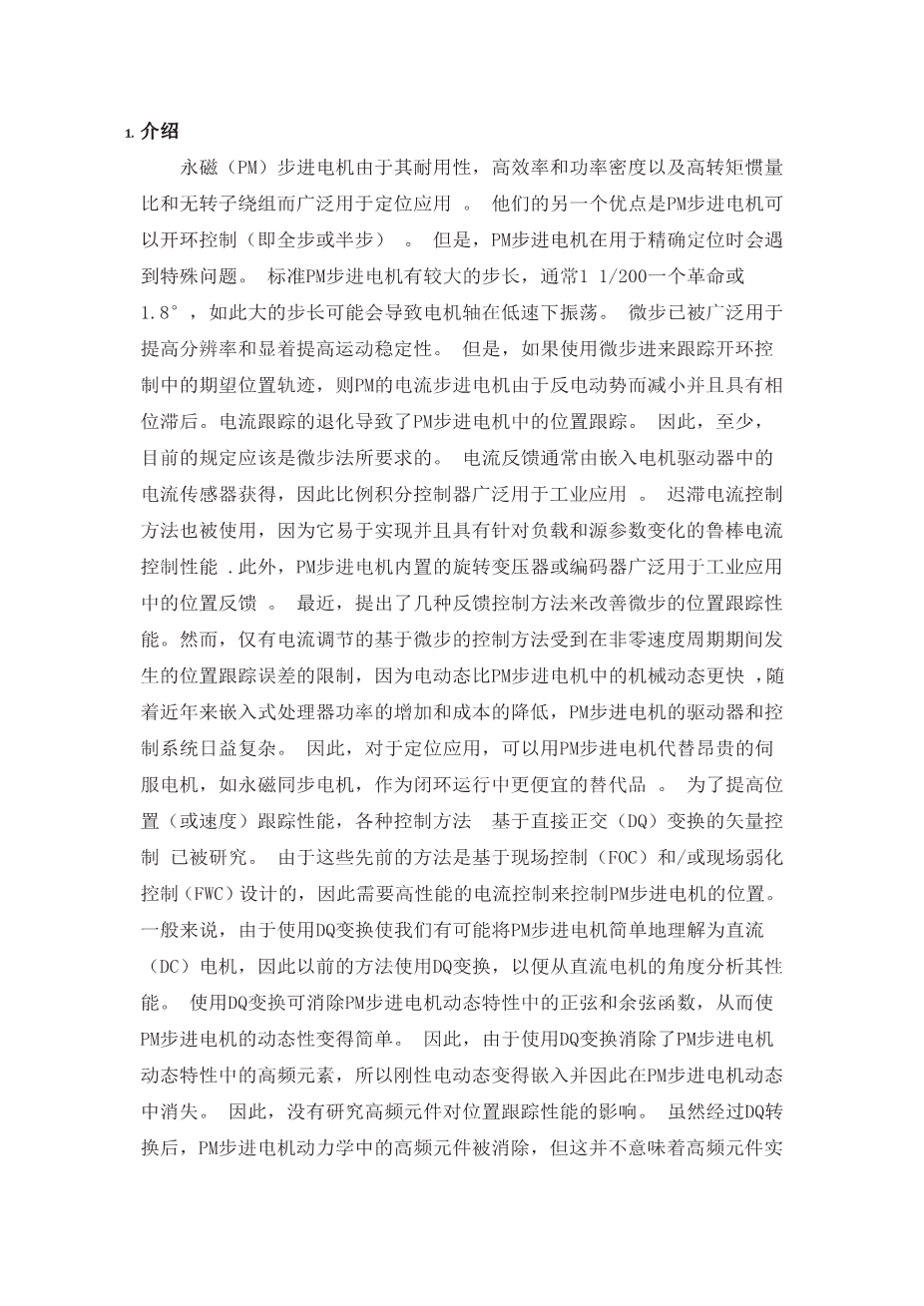Simplified torque modulated microstepping for position control of permanent magnet stepper motors
a b s t r a c t
In previous methods designed based on field oriented (and/or weakening) control, high performance of current control is required for position control of permanent magnet (PM) stepper motors. This paper proposes a simplified torque modulated microstepping (STMMS) based on singular perturbation theory for position control of the PM stepper motors. Since a two phase frame PM stepper motor model in- volves slow and fast dynamics, singular perturbation theory is applied to improve the transient response and to reduce the ripple. The torque modulated microstepping method is applied with a simplified cur- rent tracking control law obtained from singular perturbed system analysis. Using applied conditions and stability proofs, we find that the proposed control design procedure is simplified. This eliminates the high-bandwidth control efforts for the current tracking required in the previous methods. Furthermore, the STMMS does not use current feedback for the current tracking. It is shown that high performance in the current tracking does not necessarily entail high performance in the position tracking. The pro- posed method was validated by simulation and experimental results. It is observed that the STMMS not only improved transient response but also reduced ripple in position control over the previous method.
Furthermore, the STMMS used the input voltages less than the previous method does.
Keywords: Permanent magnet stepper motor Position control Singularly perturbed system
1. Introduction
Permanent magnet (PM) stepper motors have been widely used in positioning applications due to their durability, high efficiency, and power density as well as their high torque to inertia ratio and absence of rotor winding [1] . Their other merit is that PM step- per motors can be operated in open-loop control (i.e. full step- ping or half stepping) [2] . However, PM stepper motors have a specific problem when used for precise positioning. Standard PM stepper motors have relatively large step sizes, usually of a revolution or 1.8 °. Such large step sizes may cause motor-shaft os- cillations at low speeds [3] . Microstepping has been widely used for improved resolution and significantly increased motion stabil- ity [4,5] . However, if microstepping is used to track the desired position trajectory in open-loop control, the currents of the PM stepper motor decrease due to back-emfs and have the phase lags. The degradation of the current tracking results in that of the posi- tion tracking in PM stepper motor. Thus, at least, the current reg- ulation should be required in microstepping. Current feedback is generally obtained by the current sensor embedded in motor drive, so that proportional-integral controller is widely used in indus- trial applications [6,7] . Hysteresis current-control method was also used since it was simple to implement and has robust current con- trol performance against load and source parameter changes [8] . Moreover, resolvers or encoders built into PM stepper motors are widely used for position feedback in industrial applications [9–12] . Recently, several feedback control methods were proposed to im- prove the position tracking performance of microstepping [13–16] . However, microstepping based control method with only current regulation has been limited by position tracking error that occurs during the nonzero velocity period since the electrical dynamics are much faster than the mechanical dynamics in PM stepper mo- tor [17] .
With the increase in power and decrease in cost of embedded processors in recent years, drives and control systems for PM step- per motor have become increasingly sophisticated. Thus, for po- sitioning applications, PM stepper motor can be substituted for
expensive servo motors such as PM synchronous motors as a cheaper replacement in closed-loop operation [18] . In order to im- prove the position (or velocity) tracking performance, various con- trol methods [19–30] based on vector control with direct quadra- ture (DQ) transformation [31] have been studied. Since these pre- vious methods were designed based on field oriented control (FOC) and/or field weakening control (FWC), high performance of current control is required for position control of PM stepper motors. Gen- erally since using DQ transformation gives us the merit that PM stepper motor can be easily interpreted as direct current (DC) mo- tor, the previous methods used DQ transformation so that their performances were analyzed in the view point of DC motor. Us- ing DQ transformation removes sine and cosine functions in the PM stepper motor dynamics so that PM stepper motor dynamics becomes simple. Thus the stiff electrical dynamics become embed- ded and thus disappear in the PM stepper motor dynamics since using DQ transformation removes high frequency elements in the PM stepper motor dynamics. Therefore, there has been no study of the effect of high frequency elements on the position tracking performance. Although after DQ transformation, high frequency el- ements in the PM stepper motor dynamics are removed, this does not mean that high frequency elements are actually removed in the PM stepper motor. Hence a study of the effect of the high frequency elements on the position control is required. Recently, several methods based on microstepping without DQ transforma- tions were studied to improve the position tracking performance of PM stepper motor [32,33] . FOC and FWC were designed in the view point of two phase frame. However, there was also no study of the effect of high frequency elements on the position control in [32,33] .
Although all of those methods improved the position tracking performance of PM stepper motor, there is still a main problem in the
剩余内容已隐藏,支付完成后下载完整资料


英语译文共 21 页,剩余内容已隐藏,支付完成后下载完整资料
资料编号:[467455],资料为PDF文档或Word文档,PDF文档可免费转换为Word
以上是毕业论文外文翻译,课题毕业论文、任务书、文献综述、开题报告、程序设计、图纸设计等资料可联系客服协助查找。


